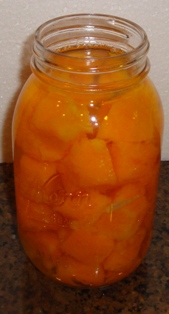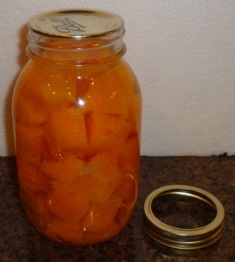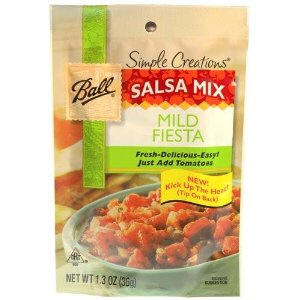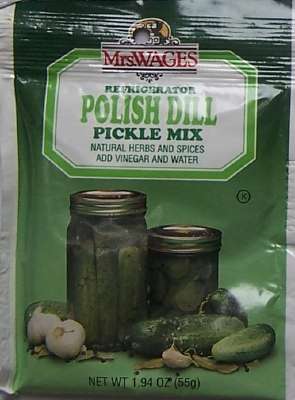
How to make home-canned butternut squash and other winter squash! In easy illustrated steps!
How to Make Home Canned Butternut Squash - and other hard winter squash!
(Note: This recipe absolutely requires a Pressure Canner)
Click here for a PDF print version
You probably take Butternut and other hard winter squash for granted. They seem to always be in the grocery store. But did you know that most winter squash can be stored or canned? Here's how to do it, complete instructions in easy steps and completely illustrated. And it is much easier than you think, using my "patented" tips and tricks! You can freeze it for later use, too. One important fact: you can the squash as cooked cubes, not a puree nor a ready pie filling. Commercial canning equipment, which you cannot buy, works differentlly - so be sure to follow these directions and do NOT mash or puree it - do that when you open the jars to use it later! And you must use a pressure canner, not a water bath canner. See this page for the safety reasons why.Directions for Home Canning Butternut Squash (and other hard winter squash)
Photos show a pumpkin, but ut is the same for butternut and other winter squash!
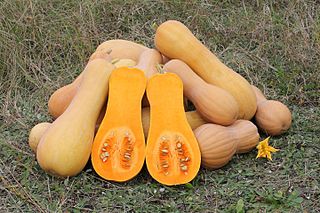 Ingredients
Ingredients
- Butternut Squash (and other hard winter squash) (see step 1)
Equipment
- A sharp, large serrated knife
- an ice cream scoop
- a large microwaveable bowl or large pot
- Pressure canner
- Canning jars with rings and new lids
Recipe and Directions
Step 1 - Get your pie Butternut Squash (and other hard winter squash)
Just like selecting any squash, look for one that is firm, no bruises or soft spots, and a good orange color. Pumpkins and squash should have a hard rind and stringless, mature pulp of ideal quality for cooking fresh. You can also use these directions for any hard winter squash, such as jarrahdale, hubbard, neck, turban, etc.
Yield: Butternut squash are medium sized. You can usually obtain about 2 or 3 cups or per squash. An average of 16 pounds of raw squash is needed per canner load of 7 quarts. Or an average of 10 pounds per canner load of 9 pint jars. This works out to an average of 21/4 pounds per quart.
Step 2 - Prepare the Squash for cooking
Wash the exterior of the
squash in cool or
warm water, no soap.
Cut the squash in half. A serrated knife and a sawing motion works best - a smooth knife is more likely to slip and hurt you!
Step 3 - Scoop out the seeds...
And scrape the insides. You want to
get out that stringy, dangly stuff that coats the inside surface. I
find a heavy ice cream scoop works great for this.
Note: SAVE THE SEEDS:
The seeds can be used either to plant squashs next year (if the squash isn't a hybrid), or roasted to eat this year! Place them in a bowl of water and rub them between your hands. then pick out the orange buts (throw that away) and drain off the water. Spread them out on a clean towel or paper towel to dry and they're ready to save for next year's planting or roast. Click here for roasting instructions! (opens in a new window)
Step 4 - Softening to squash to remove the peel / skin
There are several ways to prepare the squash; just choose use your preferred method. Most people have microwaves, and the use the least energy, so I'll describe that here. But others make good arguments in favor of using a pressure cooker, steaming on the stovetop or baking in the oven. I'll describe microwaving here, and at the end of this document, I've included alternative instructions to replace step 4, if you'd rather use a different method.a. Microwave method
Put it in a microwaveable bowl
Remove the stem, and put the
squash into a
microwaveable. You may need to cut the squash further to make it fit.
The fewer the number of pieces, the easier it will to scoop out the cooked
squash afterwards.
Put a couple of inches of water in the bowl, cover it, and put in the microwave.
Cook the squash until it just starts to get soft
Cook for 10 minutes on high, check to see if
it is soft, then repeat in smaller increments of time until it is soft
enough to separate (peel by hand) the skin easily, but the squash is not
yet mushy.. Normally it takes 20 or 30 minutes
in total. Caution: Do not mash or puree.
OR
b. Steam on the stovetop method
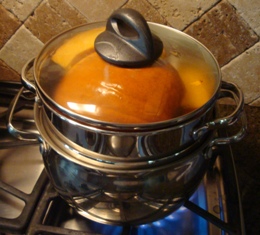
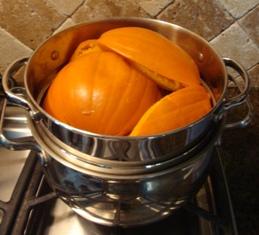
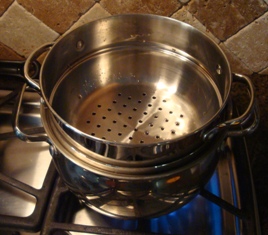
You can also cook it on the stovetop; it takes about the same length of time in a steamer (20 to 30 minutes). I use a double pot steamer, but you could use an ordinary large pot with a steamer basket inside it!: Save the cooking liquid to fill the jars - otherwise you will need to get another pot of water boiling to replace the lost liquid.
Step 5 - Peel
You should be able to easily peel off the skin using a blunt knife in one hand and an oven mitt (I like the waterproof silicone type) in the other.
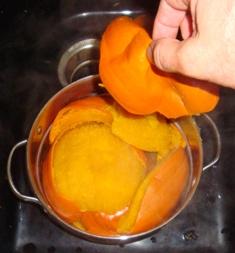 Many
times the skin or rind will simply lift off with your fingers (see the
photo at left) . I'll bet you didn't realize making your own
squash glop... err, "puree" was this easy! You may want to let
it cool a bit first.
Many
times the skin or rind will simply lift off with your fingers (see the
photo at left) . I'll bet you didn't realize making your own
squash glop... err, "puree" was this easy! You may want to let
it cool a bit first.
Step 6 - Cut into 1 inch cubes
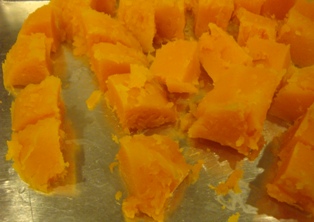 Now, cut the flesh into 1-inch cubes. Do NOT mash it!
Now, cut the flesh into 1-inch cubes. Do NOT mash it!
Note: there are many varieties of squash and some make better pies that other (due to sugar content, flavor, texture and water content. Drier, sweeter, fine-grained pies; such as butternut, "neck, jarrahdale, are excellent If your squash is much more watery than the puree in the photo at right (there should not be any free water), you may want to let it sit for 30 minutes and then pour off any free water. That will help prevent you pie from being too watery! Beyond, that, I have not found that the water makes a difference - I wouldn't be TOO concerned about it!
Step 7 - Pack the jars
 Fill jars with cubes and cooking liquid, leaving 1-inch
headspace. Fill up to 1 inch from the top with the hot cooking liquid that you
saved in step5. If you threw it out, add boiling water. Adjust the rings
and lids.
Fill jars with cubes and cooking liquid, leaving 1-inch
headspace. Fill up to 1 inch from the top with the hot cooking liquid that you
saved in step5. If you threw it out, add boiling water. Adjust the rings
and lids.
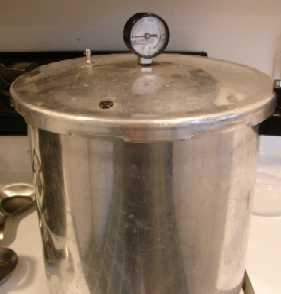 Step
8 - Put the jars in the canner and the lid on the canner (but
still vented)
Step
8 - Put the jars in the canner and the lid on the canner (but
still vented)
Using the jar tongs, put the jars on the rack in the canner. By now the water level has probably boiled down to 3 inches. If it is lower than that, add more hot tap water to the canner. When all the jars that the canner will hold are in, put on the lid and twist it into place, but leave the weight off (or valve open, if you have that type of pressure canner). And, yes, you MUST use a Pressure Canner!!!
Step 9 - Let the canner vent steam for 10 minutes
Put the heat on high and let the steam escape through the vent for 10 minutes to purge the airspace inside the canner.
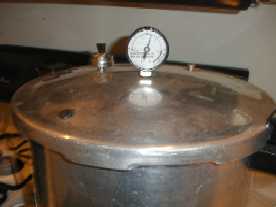 Step 10 - Put the weight on and let the pressure build
Step 10 - Put the weight on and let the pressure build
After 10 minutes of venting, put the weight on and close any openings to allow the pressure to build to 11 to 13 pounds in a dial-type gauge canner - shown in the photos (or at 10 to 15 pounds pressure in a weighted gauge canner.
Step 11 - Process for the required time
Once the gauge hits 11 pounds (or 10 pounds in a weighted gauge type), start your timer going - for 55 minutes for pint jars and quarts for 90 minutes. Adjust the heat, as needed, to maintain 10 pounds of pressure. Remember - this is an estimated time based on cubed squash - I still recommend you put the finished jars in the refrigerator afterwards.
Pressure required depends on the altitude where canning is being done. Note: the chart below will help you determine the right processing time and pressure, if you are above sea level.
It is important to learn how to operate your pressure canner by reading the owner's manual that came with your particular canner. If you cannot find your owner's manual, you can obtain find one online: Here is where to find some common manufacturer's manuals:
or by contacting the company that made your canner. Give the model number to the manufacturer, and they will send you the right manual. More information about pressure canners and a variety of models you can order.
| Table 1. Recommended process time for Winter Squash in a dial-gauge pressure canner. | ||||||
| Canner Pressure (PSI) at Altitudes of | ||||||
| Style of Pack | Jar Size | Process Time | 0 - 2,000 ft | 2,001 - 4,000 ft | 4,001 - 6,000 ft | 6,001 - 8,000 ft |
| Hot | Pints | 55 min | 11 lb | 12 lb | 13 lb | 14 lb |
| Quarts | 90 | 11 | 12 | 13 | 14 | |
| Table 2. Recommended process time for Winter Squash in a weighted-gauge pressure canner. | ||||
| Canner Pressure (PSI) at Altitudes of | ||||
| Style of Pack | Jar Size | Process Time | 0 - 1,000 ft | Above 1,000 ft |
| Hot | Pints | 55 min | 10 lb | 15 lb |
| Quarts | 90 | 10 | 15 | |
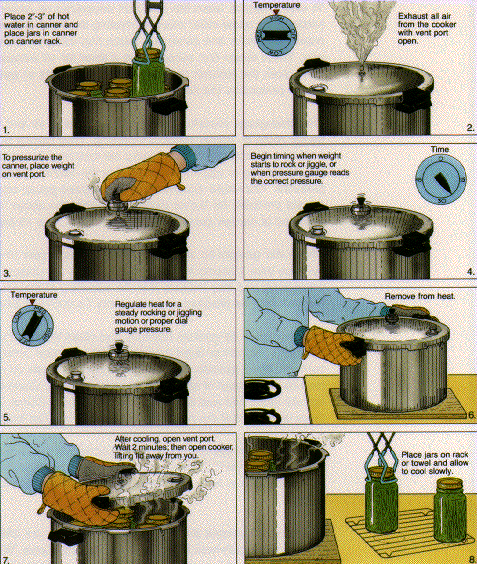

Step 12 - Turn off the heat and let it cool down
When the processing time from the chart above is up, turn off the heat, and allow the pressure canner to cool and the pressure to drop to zero before opening the canner. Let the jars cool without being jostled. After the pressure drops to zero (usually, you can tell but the "click" sound of the safety release vents opening, as well as but the gauge. Let the pressure in the canner drop to zero by itself. This may take 45 minutes in a 16-quart canner filled with jars and almost an hour in a 22-quart canner. If the vent is opened before the pressure drops to zero OR if the cooling is rushed by running cold water over the canner, liquid will be lost from the jars. Too rapid cooling causes loss of liquid in the jars!
Step 13 - Remove the jars
Lift the jars out of the water and let them cool on a wooden cutting board or a towel, without touching or bumping them in a draft-free place (until warm to the touch). You can then remove the rings if you like, but if you leave them on, at least loosen them quite a bit, so they don't rust in place due to trapped moisture. Now store them in a cool dark area, like a basement, or pop them into the fridge and you're done!
To use the cooked squash
The squash is now cooked and ready for the pie recipe. Just drain the water and puree the contents, then use as any cooked squash!How about ...
-
How to make a squash pie and How to make a flakey pie crust
-
How to make Pumpkin Bread
-
How to make pumpkin soup
-
How to make roasted pumpkin seeds
| See here for related tools, equipment, supplies on Amazon See here for related tools, equipment, supplies on Amazon |
Complete Water Bath Canner KitThis is the same type of standard canner that my grandmother
used to make everything from pumpkinauce to jams and jellies to tomato and
spaghetti sauce!. This complete kit includes everything you need: the canner, jar rack, Jar grabber tongs,
lid lifting wand, six pint jars with lids and rings, a plastic funnel,
labels, bubble freer, and the bible of canning, the Ball Blue Book. You will never need anything else except more jars and lids!
|
||
|
|
|
|
Lids, Rings, Jars, mixes, pectin, etc.Need lids, rings and replacement jars? Or pectin to make jam, spaghetti sauce or salsa mix or pickle mixes? Get them all here, and usually at lower prices than your local store! |
Looking for canning equipment and supplies?
Water bath canner with a jar rack
Pressure canners for gas, electric and induction stoves: Presto 23Qt or T-fal 22Qt
Canning scoop (this one is PERFECT)
Ball Blue book (most recent version)
Jars: 8oz canning jars for jams
Find Other types of farms:
Farm markets and roadside stands
Road trips and camping resources
Local Honey, apiaries, beekeepers
Consumer fraud and scams information
Home canning supplies at the best prices on the internet!
Maple Syrup Farms, sugarworks, maple syrup festivals
Environmental information and resources
Farms For Your Event for birthday parties, weddings, receptions, business meetings, retreats, etc.
Festivals - local fruit and vegetable festivals
Get the
most recent version of
the Ball Blue Book
With this Presto 23 quart pressure canner and pressure cooker, you can "can" everything, fruits, vegetables, jams, jellies, salsa, applesauce, pickles, even meats, soups, stews. Model 01781

You can make jams, jellies, can fruit, applesauce, salsa and pickles with water bath canners, like this Granite Ware 12-Piece Canner Kit, Jar Rack, Blancher, Colander and 5 piece Canning Tool Set

